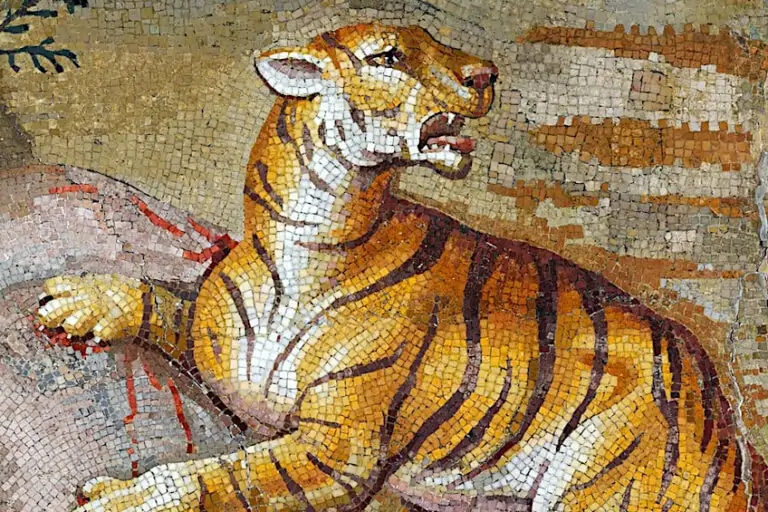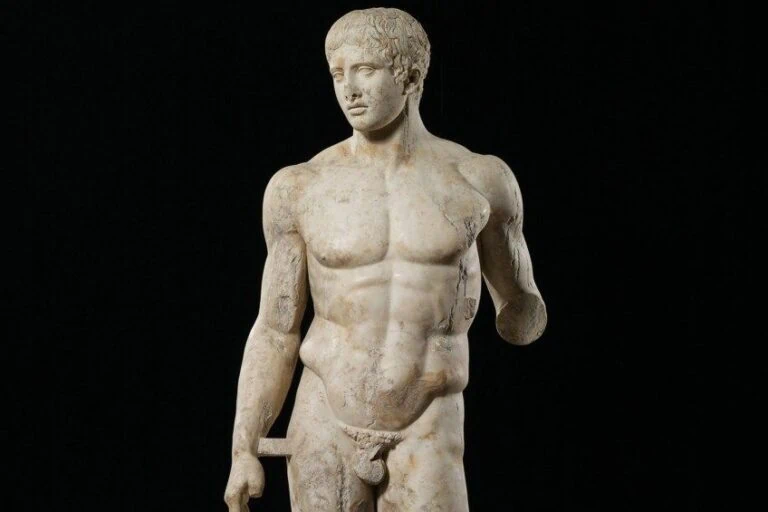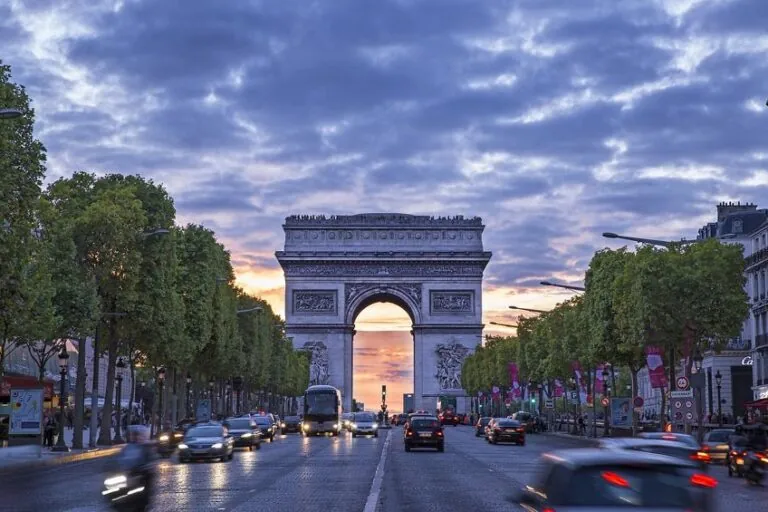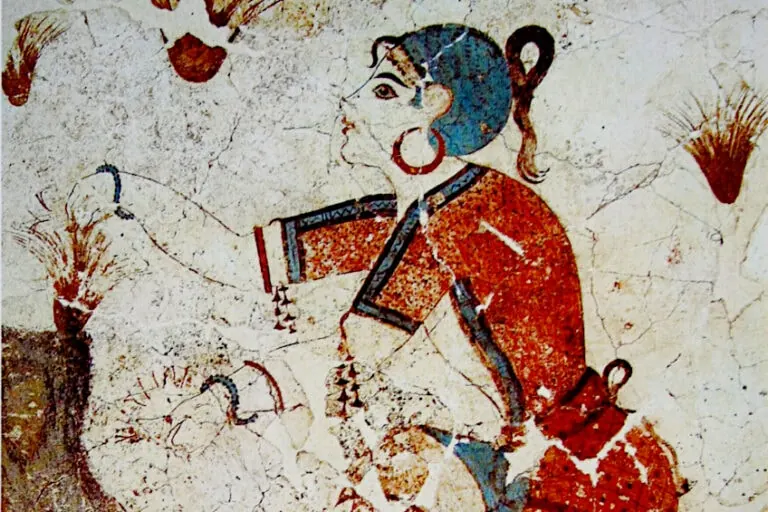Easter Island Statues – Explore the Ancient Statues of Rapa Nui
There are lots of recognizable artifacts around the world, but few of them are quite as well known as the Easter Island statues. Whether you’ve seen them on postcards, television, or renditions of them in kids’ cartoons, there’s no denying that they are an iconic sight! Even though most people are aware of them, very few people actually know what they are or why they were created in the first place. This being said, let’s have a look at what exactly the Easter Island statues are, who built them, why they were created, and why they are such a popular site these days.
Contents
What Are the Easter Island Statues?
| Artist | Ancient Rapa Nui people |
| Date Created | 1400 – 1650 CE |
| Materials Used | Tuff (compressed volcanic clay) |
| Dimensions (m) | 10 x 1.6 |
| Weight (t) | 14 – 20 |
| Current Location | Easter Island, Chilean territory |
| Meaning | Remembrance of Kings and ancestors |
| Technique Used | Hand carving and chiseling |
The faces of the Easter Island statues are somewhat synonymous with the eight wonders of the world even though they’re not part of the official list. The official name for the statues has come to be known as the Moai Statues, as this is the name of the tribe who were responsible for their construction and placement on the Island.
These statues are monoliths, which means that each one has been cut from a single piece of stone.
This practice was fairly common in the ancient world, as can be seen by the countless marble statues present in ancient Greek and Roman antiquity. These statues have a distinct style to them though, and most of them are far larger than any of the contemporary pieces found in Europe, the Middle East, and even Africa.
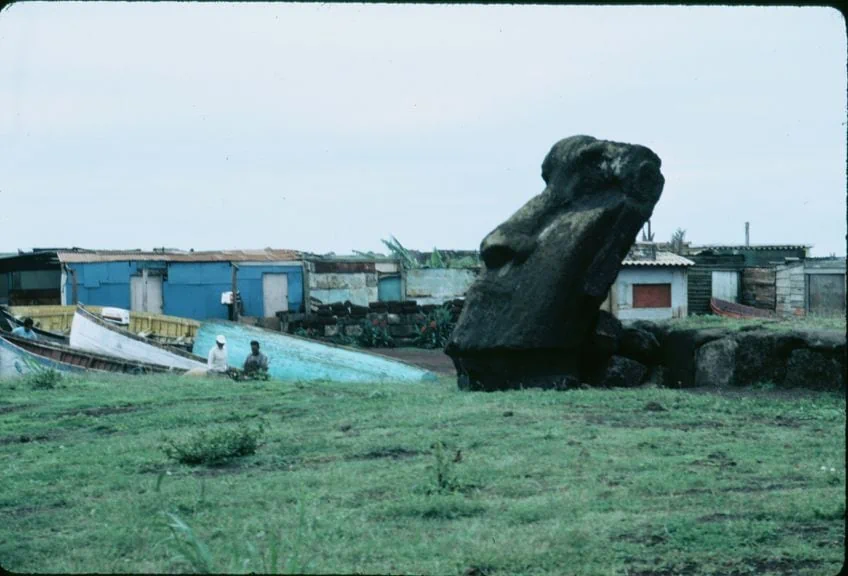 Big head of Moai near fishing village, Easter Island (1250 – 1500); Urbain J. Kinet, No restrictions, via Wikimedia Commons
Big head of Moai near fishing village, Easter Island (1250 – 1500); Urbain J. Kinet, No restrictions, via Wikimedia Commons
The natives of the island are known as the Rapa Nui. They constructed these massive monolithic figures all the way back in 1650 BCE, working with only simple hand tools and an in-depth understanding of leverage to get the job done. This would have been a herculean task back in the day, as even today it would require months of careful preparation and logistics to even begin a project of this magnitude.
Now, you might be thinking that they’re just a few stone heads, it couldn’t possibly be that difficult to cut a few vaguely humanoid shapes from stone, right? Well, yes, it definitely can. Especially considering the fact that the Easter Island statues are not just heads, they’re full-scale impressions of highly revered male leaders, kings, and ancestors of the Moai people.
The idea that the statues or only heads can be attributed to the fact that (arguably) the most popular picture of these statues is from the base of the volcano Rano Rarako.
The “toro” and bases of these statues have become buried over the years, which has made them a bit more accessible to tourists, not to mention more picturesque for those looking for a good postcard! If you’d like an idea of just how immense these statues are, consider the fact that the ones that are buried near the Rano Volcano are around five meters in height. The full height of the average Moai statue is actually around 10 meters in height, with each one weighing around 14 metric tons. There are (roughly) 1000 statues on the island, each made by hand, and with their own unique aesthetic attributes.
How Were the Easter Island Statues Made?
Ever since they were discovered, experts have wondered how the Easter Island statues were made. We mentioned previously that they’re monoliths (created from one piece of stone), so it stands to reason that they would have been carved out of the rock they’re made of. This is pretty much exactly how they were made, with hand tools used to chip away at the volcanic clay rock bit by bit.
Each of these statues weighs around 14 – 20 metric tons, and can reach sizes well over ten meters in height.
Thankfully, the process the Rapa Nui used to make these statues wasn’t nearly as labor-intensive as it could have been. What made things easier for them you ask? Well, the material these statues are made of happens to be marginally more malleable than solid marble or granite.
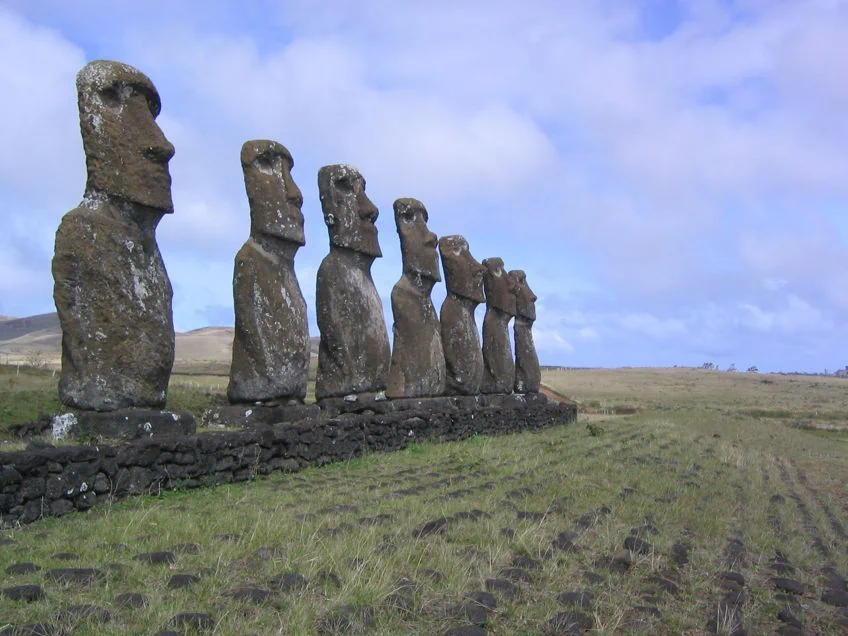 Easter Island Statues (1250 – 1500); Phil Whitehouse from London, United Kingdom, CC BY 2.0, via Wikimedia Commons
Easter Island Statues (1250 – 1500); Phil Whitehouse from London, United Kingdom, CC BY 2.0, via Wikimedia Commons
As a result, the Rapa Nui were able to use hand tools to carve out the facial features and torso of the statues with relative ease. What would have slowed down the production of these figures is the impressive height that they were carved. This would have these statues being shaped in sections, either with the statue lying over or with the help of a ladder.
Strangely, there is no evidence of a ladder being used, even in the construction of some of the tallest statues found on the island. However, it was discovered that large amounts of palm trees were cut down with the intention of harvesting their material to make rope. It is believed that these ropes would have been used to slowly lower each statue down so they could be shaped as desired. This makes sense considering that it would have been less risky and more feasible to have the statue on the ground during the construction process. The design for these statues seems to have been inspired by smaller statues of the same style that have been uncovered during excavation on certain parts of the island.
Whether these were mock-up pieces, or simply earlier designs that inspired the creation and overall aesthetic of the larger statues is up for debate. What we do know is that each statue is entirely unique, as each leader and/or king being honored by these pieces were given distinct facial features and other identifying characteristics.
There are examples of larger statues (symbolizing status) having crown-like objects on their heads. This aesthetic choice has been repeated in representations of past royalty, distinguishing them from the statues representing less prominent societal figures. The size of the statue also said a lot about the king who had it commissioned. It goes without saying that if you were an ancient king and you had loads of money to blow, you’re going to spend on commemorating your reign. Moai kings were no exception to this rule, and those with exceptional wealth spared no expense in commissioning huge statues representing themselves all over Easter Island. This being said, these statues can be considered the equivalent of a presidential portrait from this era.
Why Were the Easter Island Statues Built?
As we mentioned previously the Easter Island head statues were built to serve as a reminder of great leaders and kings alike. Initially, statues looked fairly similar, with only slight variations in their facial features and overall aesthetic. However, once demand grew for these “mementos” the Easter Island head statues became more detail-oriented, and eventually entirely unique in comparison to one another.
It does seem that there were a group of sculptors that cornered the market as far as giant statues were concerned.
It is believed that the Moai statues would be commissioned by a village, group, or village leader. The statue’s design would then be discussed and officially commissioned for production by the aforementioned group of sculptors. Nice work if you can find it!
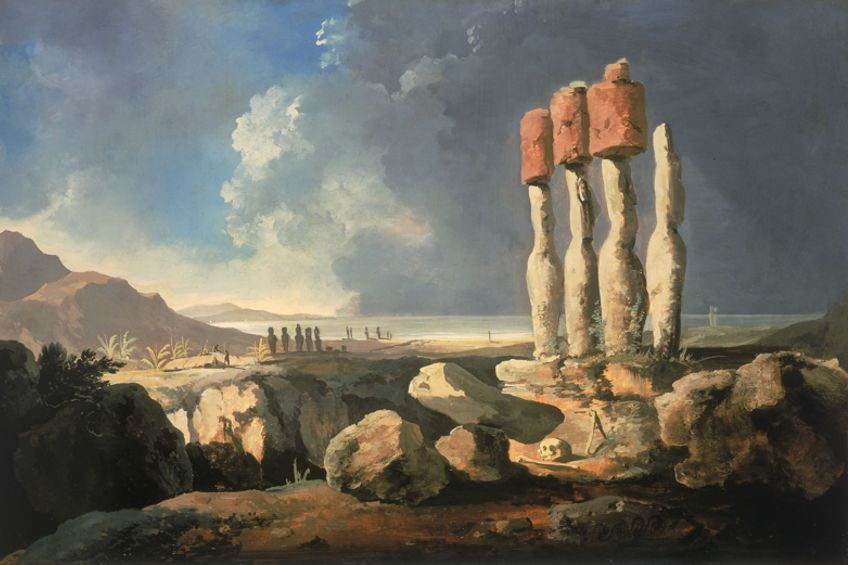 Easter-Island (c 1774 – 1777) by William Hodges; William Hodges, Public domain, via Wikimedia Commons
Easter-Island (c 1774 – 1777) by William Hodges; William Hodges, Public domain, via Wikimedia Commons
How would one pay for Moai statues of this size? Especially considering that they were in such high demand? Well, in most cases the village or group in question would pay with whatever resource they had in abundance. Whether it was mineral ore, produce, grain, or livestock, a certain amount would be agreed upon and paid to the sculpting team.
As you can probably imagine, this led to a kind of “class” competition among the neighboring tribes of Easter Island. After all, if you had enough resources to commission a bigger and better statue than your neighboring tribe, surely this meant that you were superior, right? Well, whether you agree or not, this is what happened, resulting in something of a statute boom at the time.
As this show of wealth went on, things began to get more intricate as sculptors invented new and exciting ways to make the statues look even grander.
One of them was to place a pukao on the head of the statue to represent the crown and/or hair of the ruler being represented. This was carved from one piece of clay only found on a specific part of the island, and then hoisted on top of the Moai statues. This was a pretty big deal as it was not only a display of wealth and status, but a display of the lengths that the people of a certain village or group would go to in order to secure their legacy for pretty much the rest of time. This is why the eyes and pukao were applied last, to ensure that these finer details of the piece were not damaged in transit, and likely to make the erection a bit more of an occasion.
How Were the Easter Island Statues Transported?
We mentioned previously that the statues had to be transported vast distances in order for them to be erected and finished, but have you asked yourself how a civilization without power tools or earth-moving equipment managed to move monoliths weighing upward of 14 metric tons? Well, with considerable effort and loads of manpower, it would seem. Initially, it was thought that the Rapa Nui people used wooden rollers to move the massive monoliths to their intended destination.
However, after further investigation, it was found that the roads of the time were not level, which would have resulted in the rollers failing to move, especially under the immense weight of the monoliths.
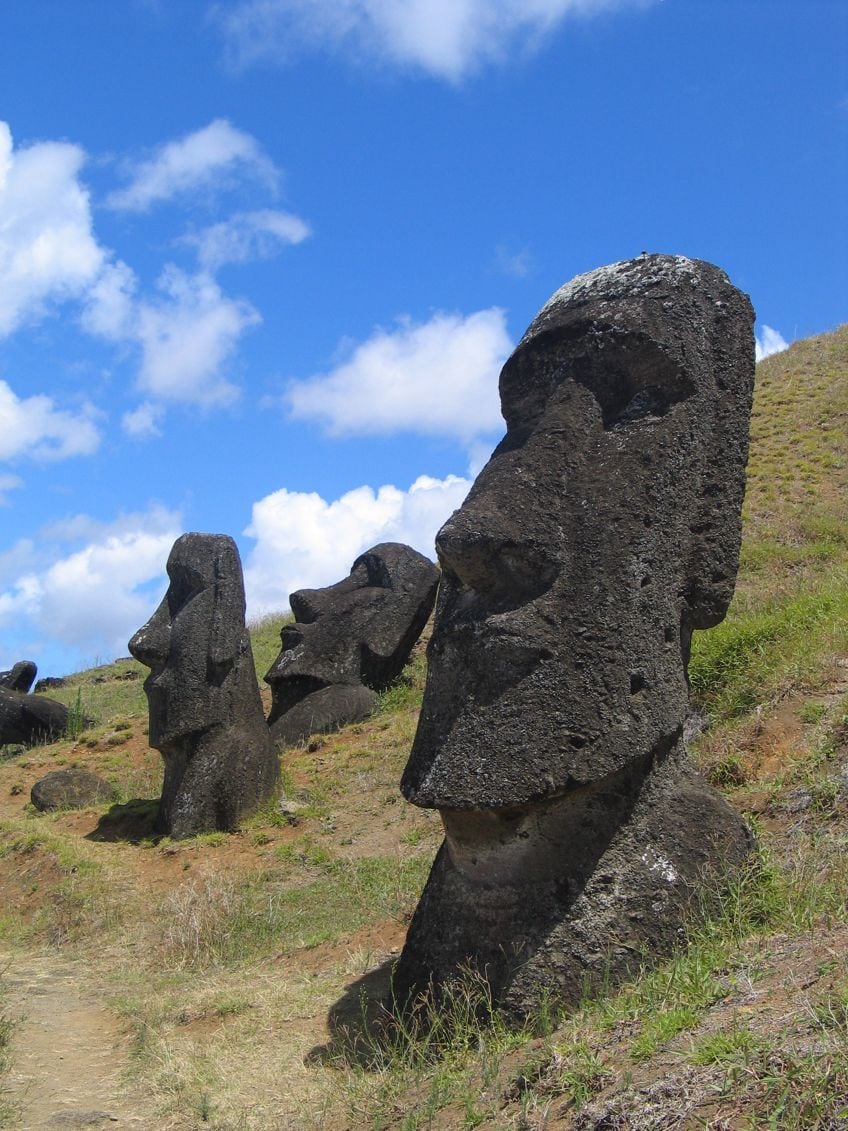 Moai Rano raraku (c. 1250 – 1500); Aurbina, Public domain, via Wikimedia Commons
Moai Rano raraku (c. 1250 – 1500); Aurbina, Public domain, via Wikimedia Commons
This being said, when one cannot use mechanical advantage to move heavy objects, the only option left is to use physical strength. It is unknown whether the monoliths were rolled or dragged toward their intended destination, but the Rapa Nui people seem to have gotten the job done through ingenuity and sheer force of will (at least by the look of things).
Transportation Theories
There are a number of theories as to how exactly these huge statues would have been transported, even with the technology we have today. This has led some to experiment with different means of transporting Rapa Nui replicas in an attempt to either prove or disprove various means of transportation. One means that has been tried and proven is (surprisingly) using wooden rollers. For this method, a replica of a Rapa Nui statue was created on a wooden platform with rollers underneath. The statue was then transported to its intended location in the upright position, only taking around 25 people to get the job done.
The results of this objectively successful experiment showed that a statue weighing around nine metric tons could be moved around 40 meters in just under two minutes with the aforementioned 25 people working in tandem.
The experiment was executed by archaeologist Charles Love from America and has been the only successful recorded transportation attempt to date. This theory would explain loads of other factors surrounding the Rapa Nui people’s history as well. The amount of wood it would have taken to construct both the platforms and the wooden rollers would have been staggering. This would have resulted in deforestation pretty quickly, which in turn would have resulted in no more statues being able to be transported to their intended location, which would have stifled the production of said statues.
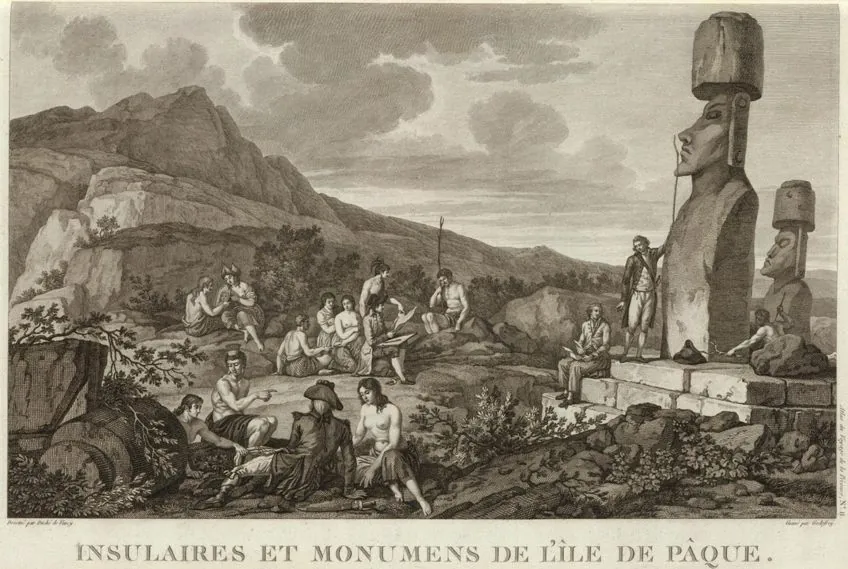 Monuments et insulaires de l’île de Pâques (1786) by Duché de Vancy; Duché de Vancy, Public domain, via Wikimedia Commons
Monuments et insulaires de l’île de Pâques (1786) by Duché de Vancy; Duché de Vancy, Public domain, via Wikimedia Commons
There have been other attempts to move the statues using various theoretical techniques. One notable attempt was done by taking advice from the native Rapa Nui people. According to ancestral legend, the statues “walked” their way to their intended destinations. This was taken somewhat literally and resulted in a statue being harnessed with rope in an attempt to waddle it to a new destination. As you can probably imagine, this took considerably more effort than using a platform with wooden rollers.
However, even though it was significantly slower than using the wooden rollers, once enough momentum was achieved, the statue was able to be walked to its intended spot. This shows that there might be more than a little bit of truth to the Rapa Nui legend.
Unfinished Statues
While it might seem like all of the statues on Easter Island are complete, there are actually quite a few of them that have never been completed. These are primarily located near the base of the volcano where the Tuff is gathered. How can one tell that these statues have not been completed you ask? Well, you can tell because they’re all still very much in the production process. The statues would be carved while the monolith lay horizontally on the ground. This work was usually done on an elevated surface, and once the initial carving and chiseling on the front of the statue would be complete, the statue would be raised using a rope and pulley system until it was upright.
The now upright statue would be lifted into the air and lowered over the edge of the elevated surface.
Once the statue was firmly on the ground, the “back” of the monolith would be carved and chiseled as desired. The incomplete statues stand out because they either have no carving present on their rears, or they have not yet been raised upright in order to be lowered and completed. There is another reason as to why these statues stand/lie incomplete on the hill. It should come as no surprise that it is far easier to sculpt these pieces than it is to move them, therefore, plenty of statues were abandoned if they were considered to be too labor-intensive or large to move. This makes sense considering that they would have been transported hundreds of meters with no mechanical or technological assistance.
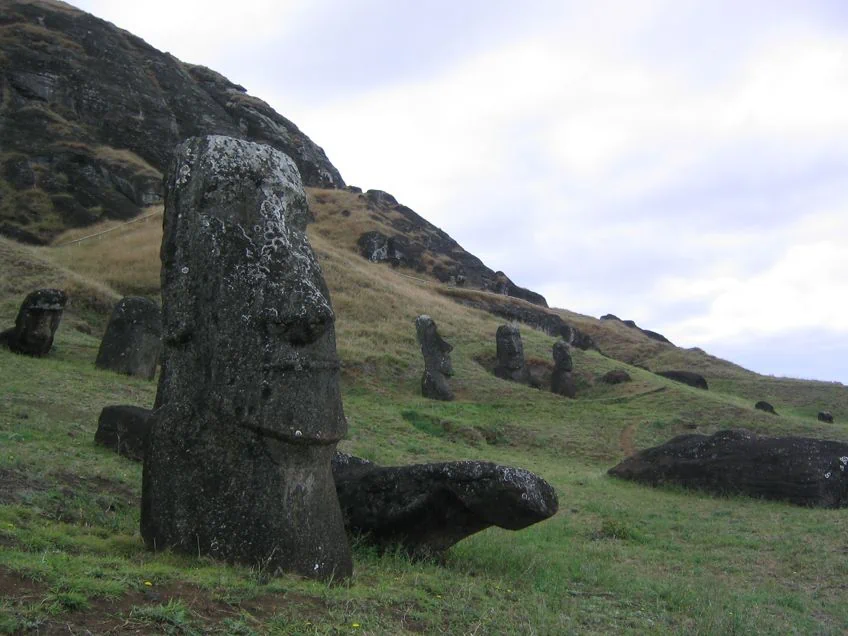 Easter Island Statues (c. 1250 – 1500); Phil Whitehouse from London, United Kingdom, CC BY 2.0, via Wikimedia Commons
Easter Island Statues (c. 1250 – 1500); Phil Whitehouse from London, United Kingdom, CC BY 2.0, via Wikimedia Commons
If you’d like an idea of just how much effort it would take to transport, erect, secure, and place a crown on one of these statues, consider the rope alone would span over 76.2 meters and weigh over a metric ton when deployed. This would require many people to pull and hold on to these ropes to erect the statue once it arrived at its intended location. This is excluding the fact that once the statue was upright, a crown might need to be added as per the request of the king who commissioned its construction.
Once constructed, these statues would remain exactly where they were erected for the rest of their lives, which judging by their state today, it’s a really long time indeed.
Evolution of the Easter Island Statues
Like any art form, the style of the easter island statues developed over time. This is similar to how Greek and Roman architecture (and statues) developed fairly rudimentary figures into the high-detail, refined representations we see today. However, instead of hyperrealism, the Rapa Nui people simply sought to streamline the design of their statues. Instead of the bulky designs that would take close to 25 people to move about and rotate while it was carved, only the head remained bulky while the rest of the “body” became slender.
The level of detail improved as well, including inlays in the eye sockets of the statues that were believed to be active; they believed in powers inherent in each figure.
Who Are the Rapa Nui People?
The Rapa Nui people are the indigenous inhabitants of Easter Island. They are of Polynesian descent and make up around 60% of the total population of the island. Most of them reside in the mainland of Chile and have been there since the inception of the island.
Most of the inhabitants of the island (both native and immigrant) are bilingual, speaking both Spanish and native Rapa Nui.
The total population of the island wouldn’t be considered large even by most conservative metrics, with a census taken back in 2017 putting the inhabitants of the island at around 7,750 people in total. This might seem like a minuscule amount of people, but for an island that’s only around 163,6 km², everyone seems to be using every square inch of inhabitable land on the island, and pretty well we might add.
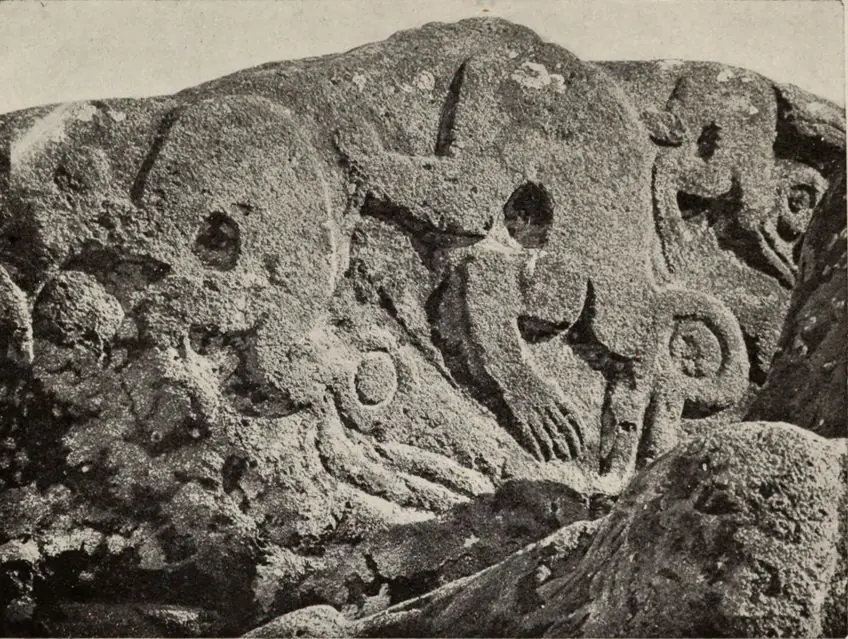 A Rock At Orongo Carved With Figures Of Bird-Men (1250 – 1500); See page for author, Public domain, via Wikimedia Commons
A Rock At Orongo Carved With Figures Of Bird-Men (1250 – 1500); See page for author, Public domain, via Wikimedia Commons
The Rapa Nui people appear to be very proud of their lineage, history, and cultural and religious practices. Demonstrations of their way of life, traditional dances, and tourism of their lands have brought significant revenue to the island. However, there have been clashes between the Rapa Nui people and Chilean police over the sovereignty of their land and oceans.
The Rapa Nui people believe that they should be able to decide what happens to their lands.
The Chilean authorities intend on creating a marine and wildlife reserve on the island, but the Rapa Nui are adamant that the preservation of their wildlife, oceans, and plant life should be left up to them, as it is their land that has been passed down to them for generations.
Origin of the Rapa Nui People
Considering that they were some of the first people to ever inhabit the island, it’s easy to assume that the Rapa Nui people have been there forever. However, thanks to DNA analysis and carbon dating of skeletal remains found on the island it seems that the Rapa Nui people have only been present on the island since around 1200 CE. This doesn’t mean that they haven’t been around for longer than this, there is simply no evidence to support any claims that they were. Further analysis of genetic material has determined that the Rapa Nui people are of Polynesian descent, with a trace of both Amerindian and European lineage scattered throughout their genes.
What does all of this mean? Put simply, it means that the group of people who settled on Easter Island and took up the title of Rapa Nui had ancestors that can be traced back to Europe and the Americas, but how far this genetic link goes back is up for debate.
Regardless, the Rapa Nui have formed their own cultural identity, traditions, and lineage since then. Even though the Rapa Nui people’s claim to the island is completely justified, even as early on as 1870 CE European settlers visited the island and attempted to claim it for Spain. The most notable of these colonists were Jacob Roggeveen and James Cook who are both believed to have found Easter Island by accident while in search of other lands.
Toppling of the Statues of Rapa Nui
The statues of Rapa Nui are incredibly heavy, and it’s hard to imagine them being thrown over by anything less than something their size and weight. However, many of them have been toppled over the years, either intentionally or through completely fortuitous events.
According to records, in 1722, all of the statues were still standing upon the visit of European settlers.
However, according to later records, virtually all of the statues had been toppled over by the 1800s, leaving historians and archaeologists alike speculating as to what could have possibly led to this sudden change in such a relatively short period. The leading theory is that the statues were toppled over when neighboring tribes warred with one another.
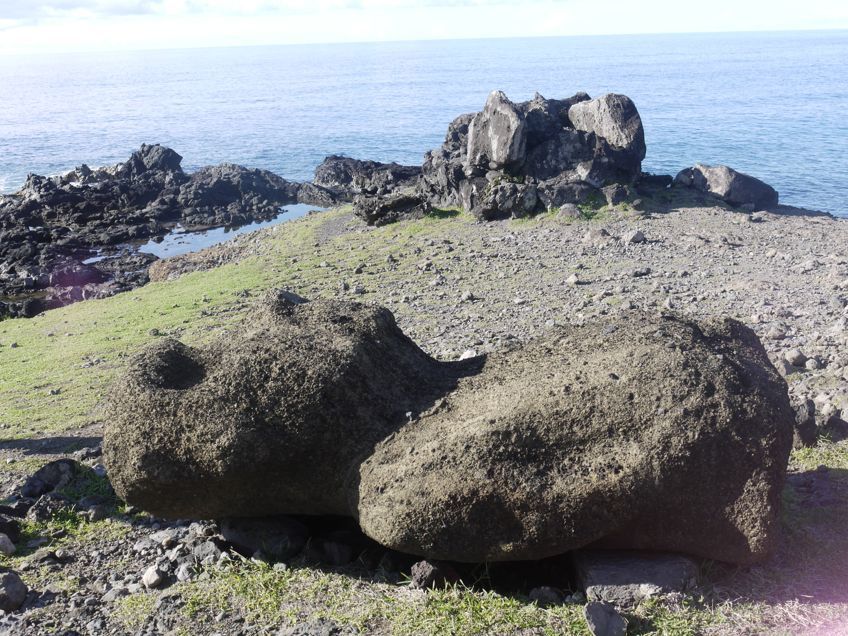 Easter Island (1250 – 1500); Mike W. from Vancouver, Canada, CC BY-SA 2.0, via Wikimedia Commons
Easter Island (1250 – 1500); Mike W. from Vancouver, Canada, CC BY-SA 2.0, via Wikimedia Commons
This would have been a means of adding insult to injury, especially if the tribe that had the statues of their leaders knocked over were the losers of the conflict. Pretty mean stuff, but then again, all is fair in love and war. Their other theory is that imperfections in the materials or simply strong enough winds could have led to some of the statues being toppled over. Considering the amount of force needed to topple a statue of this size combined with the fact that they are seated on large stone bases means that weather conditions being responsible for them falling over is highly unlikely.
This doesn’t mean that it’s an impossible scenario though, and there is still much speculation about why and how these statues were grounded.
The Legend of Nuahine Pīkea
Aside from weather and humiliation tactics, there is a Rapa Nui tale that seems to explain why the statues all fell over, simultaneously we might add. According to the legend, there was once a woman named Nuahine Pīkea who possessed rather strong Mana (a spiritual and physical power). Nuahine Pīkea became rather upset one day, which resulted in her rage toppling the statues of Rapa Nui.
What could possibly make someone so upset? According to the legend, her four children had been instructed to leave her some food, but instead, they ate it all by themselves, leaving her nothing to eat upon returning home. The force of her anger caused all of the statues to topple over and the island to tremble.
What Tools Were Used to Carve the Easter Island Statues?
When most visitors to the island see the Easter Island statue for the first time, they often ask how the Rapa Nui people managed to make them with such rudimentary tools. There are two facets that make up the answer to this question. Firstly, the tools that were used to carve and sculpt the Easter Island statues were known as “toki”. These are essentially handheld chisels that would be used pretty much the same way you would use any other hand tool, with striking force.
These chisels were a pretty common hand tool, and they have been found in digs all over the island, but in larger concentrations around the base of the Easter Island statues.
 Easter Island Statues Face (1250 – 1500); Mike W. from Vancouver, Canada, CC BY-SA 2.0, via Wikimedia Commons
Easter Island Statues Face (1250 – 1500); Mike W. from Vancouver, Canada, CC BY-SA 2.0, via Wikimedia Commons
As with any hand tool, there are many variations of the toki, all of them varying considerably in size and quality. Some of the best quality toki’s were made of a rock called Hawaiite, which has been found to be the hardest mineral available on the island. These would have been challenging to make, but they would have made shaping and cutting the monoliths significantly easier in the long run. This mineral is native to the island and can only be found in one section of the island known as the “Rua Toki-Toki” on the Northern end.
As you can imagine, this made the mineral quite scarce, and when something scarce is in high demand it tends to come at a premium. This led to the mineral becoming quite coveted among crafters and tradespeople alike.
The Extra-Terrestrial Theory
If you’ve ever watched the History Channel late at night, then you’re probably well acquainted with the ancient alien theory. Until recently, there were several theories that suggested visitors from another world aided in or were entirely responsible for the creation and positioning of the Easter Island statues. Is there any truth to this?
Well, no. While it’s still very much up for debate as to whether we’re alone in the universe, thanks to solid archaeological research and scientific inquiry, we can say with the utmost confidence that the Easter Island statues are, indeed, manmade.
This, in conjunction with the fact that the Rapa Nui people have outright stated that the statues were built by their ancestors, doesn’t leave much room for speculation. If this still isn’t enough evidence to quell the conspiracy theorist inside you, there are travel logs detailing a sailor’s encounter with the Rapa Nui people. His name was Jacob Roggeveen, and in his logs dating back to 1722, he paints a picture of statues in various states of decay and even mentions priests worshiping the statues in white robes. This would coincide with theories that the statues were revered and worshiped until European colonists arrived on the islands. There is also evidence of the platforms the statues are stationed on known as “ahu” being reused as old statues were taken down and new ones were erected.
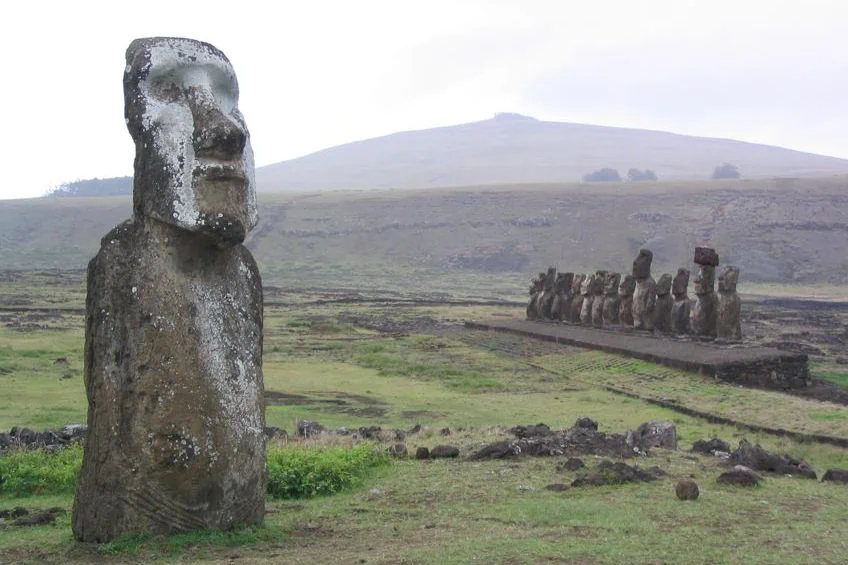 Lone Moai Statue (1250 – 1500); Phil Whitehouse from London, United Kingdom, CC BY 2.0, via Wikimedia Commons
Lone Moai Statue (1250 – 1500); Phil Whitehouse from London, United Kingdom, CC BY 2.0, via Wikimedia Commons
Now that you know what the Easter Island statues are, who the Rapa Nui people are, how these huge statues were constructed, and how they were transported all over the Island, it’s time for you to get out there and put your newfound knowledge to the test. Remember that lots can be learned from ancient cultures, and that they laid the foundation for the world we live in today.
Frequently Asked Questions
What Are Easter Island Statues Called?
The Easter Island statues are one of the great wonders of ancient societies, but this isn’t their official name. What are Easter Island statues called then? Officially, they’re known as both the Rapa Nui statues and the Moai statues.
How Old Are the Easter Island Statues?
One of the most asked questions about the large statues found on Easter Island is how old they are. How old are the Easter Island statues then? The oldest ones have been dated as being built all the way back in the year 1300!
How Did the Easter Island Statues Get There?
Contrary to what some people would have you believe, the Easter Island statues were not brought to the island by other people. The statues were actually built on the island by the Rapa Nui people and moved to their locations using various primitive means.

I am deeply passionate about history and am constantly fascinated by the rich and complex stories of the past. As the editor-in-chief of learning-history.com, I have the opportunity to share this passion with a wide audience through the creation and distribution of engaging and informative content about historical events, persons, and cultures. Whether it’s through writing articles and blog posts or creating videos or podcasts, I strive to bring the past to life in a way that is both accurate and enjoyable. My expertise in history, combined with my strong writing and communication skills, allows me to effectively communicate complex historical concepts and make them accessible and interesting to a wide range of readers. I am truly grateful for the opportunity to share my love of history with others through my work on learning-history.com.


